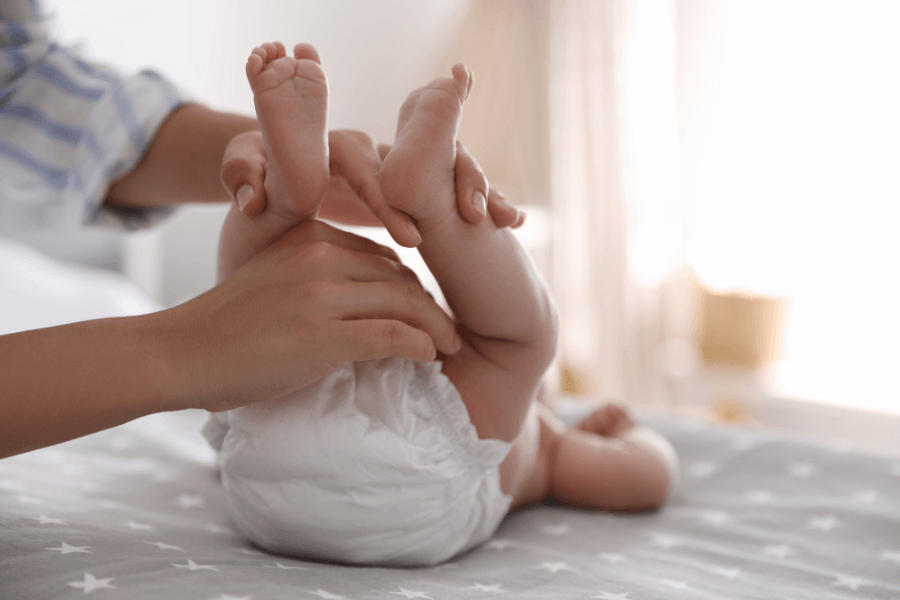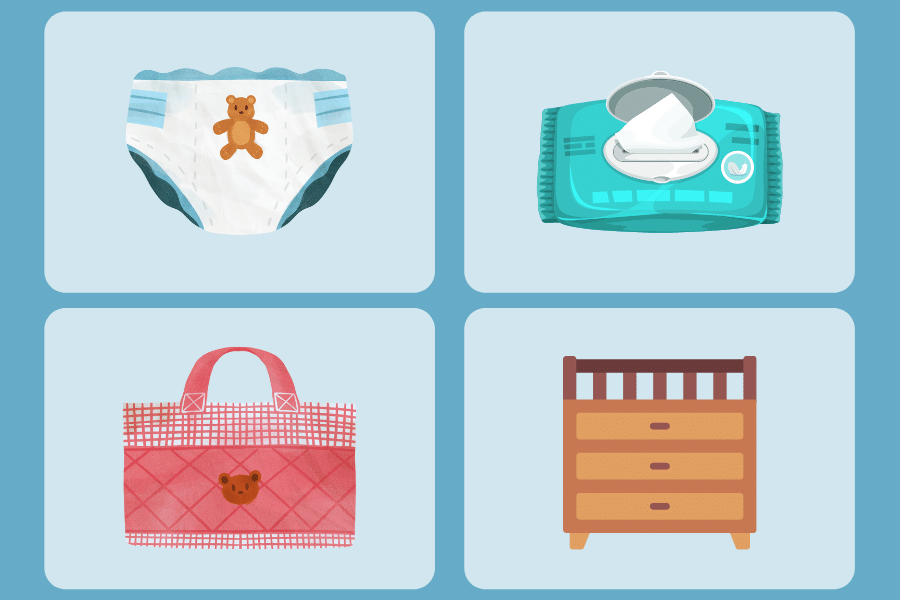The best nappies for newborns 2025
Disposable or reusable, these are essential unless you plan to do elimination communication.
DISPOSABLE NAPPIES
(For reusable nappies, click here.)
Pros of disposable nappies
They are very convenient as you don’t have to do repeated washing and drying.
They are more absorbent than reusable nappies.
You don’t need to make a large initial payment.
Cons of disposable nappies
They end up in landfill, where they take an estimated 500 years to decompose.
They are more expensive over time.
You will be constantly buying nappies.
NAPPY FEATURES TO LOOK OUT FOR
Nappies have come on a long way since the first disposable in the UK in 1982. Here are some features you will come across when choosing the best nappy for your baby.
Wetness indicator
This is a strip on the outside, which changes colour when the nappy is wet. Previously this could only be done but feeling or smelling the nappy. It will be especially useful if your baby has very sensitive skin and needs to be changed very regularly. This feature is mostly available in nappies up to size 2.
Sensitive skin nappies
These are for babies with skin that gets easily irritated. Here’s what the various labels mean:
Dermatologically tested - They have been tested by a dermatologist to see how they react to a baby’s skin. There is no standardised test. For the results, contact the company.
Approved by Allergy UK - Allergy UK is a charity which aims to improve the lives of those with allergies. They review or test products to ensure they are suitable for sensitive skin.
Approved by the British Skin Foundation - They raise money to research skin diseases. Accreditation is offered by reviewing a brand’s research into its own product to ensure any claims are not misleading.
Navel-friendly cut
Perfect for newborns, these nappies are cut so to provide space for the umbilical cord stump and prevent rubbing.
Stay dry system
Most modern disposables will have some kind of stay-dry system, which absorbs the moisture to keep the baby feeling dry for as long as possible. Some will offer up to 12 hours of protection, making them great for nighttime use.
Double leg cuffs
These can be found on Pampers New Baby nappies as well as Pampers Baby-Dry (sizes 3-5) and their Active Fit nappy pants. They offer extra protection from any wetness escaping.
Eco-friendly nappies
A nappy can take an estimated 500 years to decompose in landfill. In recent years there has been an increase in nappies that are more eco-friendly by using mostly plant-based materials.
For more on this see: Eco-friendly nappies and wipes: do any actually biodegrade?
WHAT SIZE NAPPIES SHOULD YOU BUY?
The sizes vary slightly between brands but generally:
Size 0 is for newborns that are 1-2.5 kg (2.2-5.5 lb) so these are for small or premature babies.
Size 1 is for newborns that are 2-5 kg (4.4-11 lb). Most babies start with this size.
Size 2 is for babies that are 4-8 kg (8.8-17.6 lb).
how do you know when to go up a bigger nappy size?
All nappy brands have a recommended weight range on them but here are some other signs that it’s time to move up to the next size:
The nappy is leaving red marks on the baby’s tummy and thighs.
The nappy isn't properly covering their bottom.
Your baby seems in discomfort and pulls at the nappy.
The fastening tapes don’t reach the centre of the waistband.
You can’t fit two fingers comfortably under the waistband.
The nappy starts leaking more than usual.
Asda Little Angels nappies have lines where the tabs go. A well-fitting nappy will reach past the lines. When it’s time to go up a size they will no longer reach.
What does the + sign on nappy sizes mean?
If a nappy is described as size 4+, for example, the + sign indicates that it’s pretty much the same size but it has increased absorbency. This makes them more suitable for nighttime use.
How many nappies should you buy before the birth?
How often a baby needs their nappy changed depends on how sensitive their skin is. Some will need their nappies changed up to 12 times a day.
8 OF THE BEST DISPOSABLE NAPPIES TO BUY
This list has been narrowed down to the very best with thorough research and the following considered:
Consumer reviews
Best-seller lists
Recommendations from industry experts
Award-winning products
Personal experience and the products loved by other parents.
The list is updated annually. It was last updated on 28th November 2024.
If you buy through a link, we may earn a small affiliate commission. 5% of profits are donated to UK Baby Banks to help parents in need of essentials.
1. Aldi Mamia Newborn Premium Dry Fast
Why buy these nappies?
Aldi Mamia nappies regularly win awards and are of excellent quality at a great price.
Key features
For babies between 2-5kg (4-11lbs).
The dry fast technology will keep your baby comfortable for longer.
Accredited by the Skin Health Alliance they are free from perfume, lotion or latex.
They have a wetness indicator so that it’s clear when nappies need changing.
Cord-friendly cut-out shape.
2. Pampers new baby
Why choose these nappies?
Pampers are one of the oldest and most popular disposable nappy brands and have a wide range of nappy types. For newborns, you can choose between New Baby and Harmonie. New Baby is slightly cheaper.
Key features
Available in size 0 (for babies under 3kg) to size 3 (6-10kg).
Dermatologically tested and approved by The British Skin Foundation.
Navel-friendly shape (in sizes 0-2).
Wetness indicator.
Double leg cuffs to prevent leaks.
Quick dry core to keep your baby dry for up to 12 hours.
3. Pampers Harmonie
Why choose these nappies?
Harmonie is even more gentle than Pampers New Baby nappies on a newborn’s delicate skin. They use premium cotton and plant-based fibres and contain no allergens.
Key features
The smallest size is 1, which is suitable for babies that weigh between 2 and 5kg. (4.4 - 11lbs)
Up to 12 hours of dryness.
Approved by dermatologists from Skin Health Alliance.
Navel-friendly cut to protect the umbilical cord stump of a newborn.
They also feature a wetness indicator.
Made from cellulose from certified FSC forests.
Made with 100% renewable energy.
4. Sainsbury’s little ones
Why buy these nappies?
These are a great price and are very soft.
Key features:
3D liner for excellent absorbency to keep your baby dry.
Each nappy has a wetness indicator.
5. asda little angels
Why buy these nappies?
Very popular, award-winning and excellent value for money.
Key features
SmartFlo technology absorbs wetness quickly and then evenly distributes it.
Contoured at the front to protect a baby’s umbilical cord stump.
Wetness indicator.
every changing product - in order of popularity
6. Pura eco nappies
Why buy these nappies?
These are eco-friendly nappies made from soft, organic cotton.
Key features
The absorbent core is made from FSC-certified plant fibres. The outer layer is organic cotton.
Accredited by Allergy UK and The British Skin Foundation.
Channel technology draws moisture away for up to 12 hours of protection.
Wetness indicator strip.
They use 100% renewable energy and fully recyclable paper packaging.
Certified vegan and cruelty-free.
Made in the UK.
They are partnered with Nappicycle in a drive to help reduce the number of nappies going into landfill.
7. Eco by Naty
Why buy these nappies?
Another well-known eco-friendly nappy brand. These are Swedish and guarantee no oil-based plastic will touch your baby’s skin.
Key features
Made from plant-based fibres with no plastic or chemically treated materials touching the baby's skin.
Sustainably produced from FSC-certified forests.
Hypoallergenic and dermatologically tested.
OEKO-TEX Standard 100 materials, which means they are certified to be free from harmful chemicals.
Renewable plant-based packaging.
Cruelty-free.
8. Kit & Kin nappies
Why buy these nappies?
Cruelty-free nappies from an ethical brand. For every 10 customers that buy a nappy subscription, they buy and protect one acre of tropical rainforest through the World Land Trust.
Key features
Anything that comes into contact with a baby’s skin is sustainable plant-based material and around 75% is biodegradable.
They use 100% sustainable packaging.
Patented channel technology to distribute wetness evenly and a flash dry layer to protect your baby’s skin from the moisture.
From the blog:
MORE OF THE BEST:
Changing mats • changing tables • changing bags • baby wipes • nappy rash cream • nappy bins • baby bottles • breast pumps • baby monitors














Disposable nappies take an estimated 500 years to decompose. If you wore them as a child, they all still exist somewhere. Baby wipes ‘only’ take 100 years to break down. But how much better are eco-friendly disposables, wipes and nappy sacks? Do any actually biodegrade, can they be home composted and what are the eco-credentials of five of the main eco nappy brands?